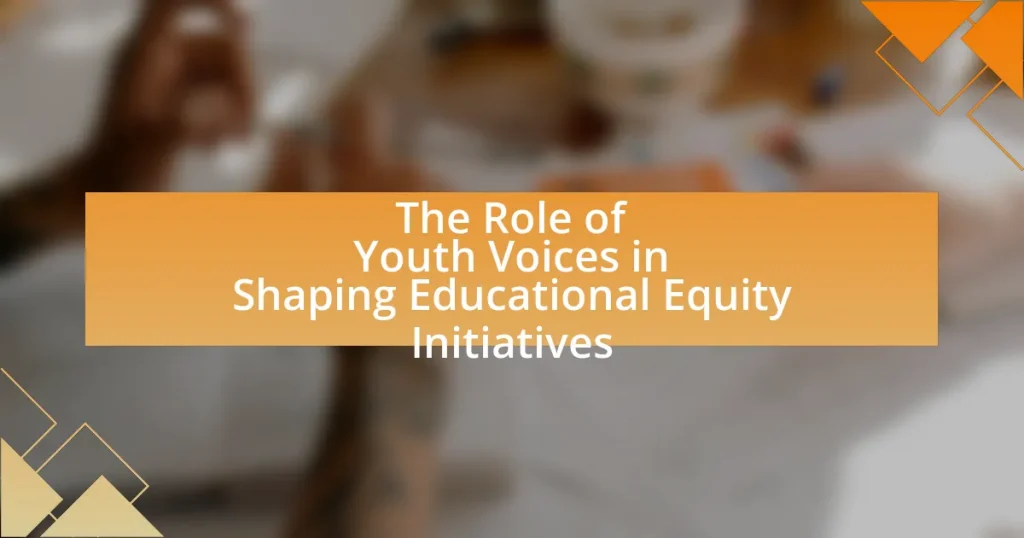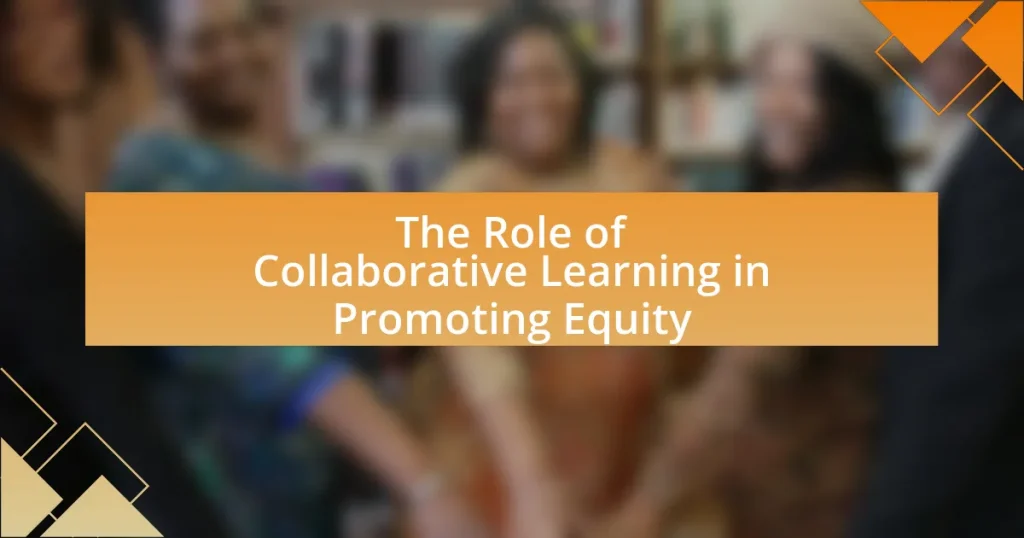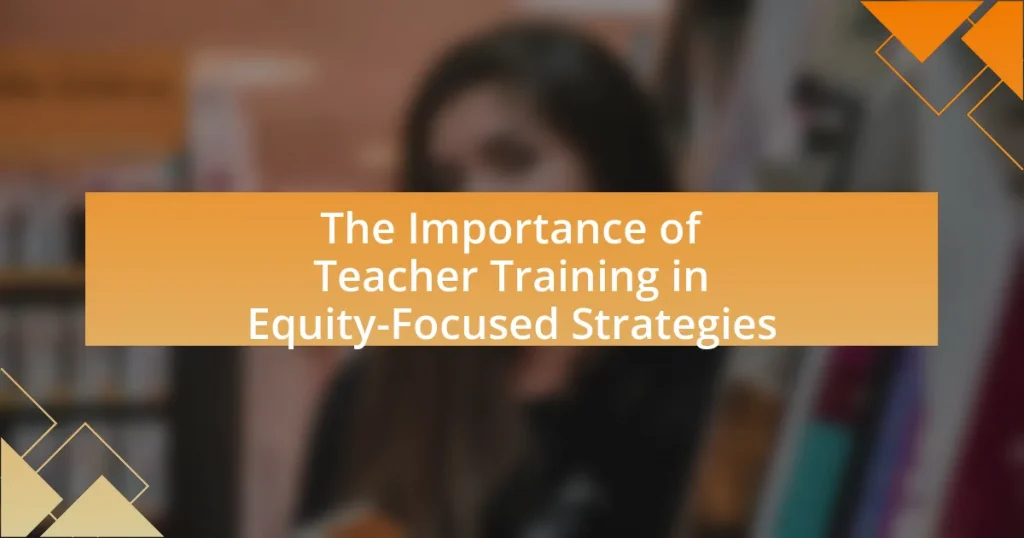The article focuses on the critical role of youth voices in shaping educational equity initiatives. It highlights how youth participation provides unique insights into their experiences and needs, ensuring that policies address the challenges faced by marginalized groups. The article discusses the importance of youth engagement in decision-making processes, the innovative perspectives they bring, and the influence they have on policy decisions. Additionally, it examines the barriers youth face in advocating for educational equity and outlines methods for enhancing their participation, ultimately demonstrating that their involvement leads to more effective and inclusive educational outcomes.

What is the Role of Youth Voices in Shaping Educational Equity Initiatives?
Youth voices play a crucial role in shaping educational equity initiatives by providing insights that reflect their unique experiences and needs. Their participation ensures that policies and programs address the real challenges faced by marginalized groups, fostering inclusivity and relevance. Research indicates that when youth are actively involved in decision-making processes, such as through student councils or advocacy groups, the resulting initiatives are more effective and responsive. For instance, a study by the National Youth Leadership Council found that youth engagement in educational reform leads to improved outcomes in both academic performance and social-emotional development. This evidence underscores the importance of integrating youth perspectives to create equitable educational environments.
Why are youth voices important in educational equity initiatives?
Youth voices are important in educational equity initiatives because they provide unique perspectives that reflect the experiences and needs of their communities. Engaging youth in these initiatives ensures that policies and programs are relevant and effective, as they can articulate the challenges they face in accessing quality education. Research shows that when youth participate in decision-making processes, it leads to more inclusive and equitable educational outcomes, as evidenced by studies indicating that schools with active student engagement report higher levels of satisfaction and achievement among diverse student populations.
What unique perspectives do youth bring to the conversation on educational equity?
Youth bring fresh, innovative perspectives to the conversation on educational equity by highlighting their lived experiences and advocating for systemic change. Their insights often reflect the challenges they face in accessing quality education, such as disparities in resources and support based on socioeconomic status or race. For instance, a report by the National Youth Rights Association emphasizes that youth are uniquely positioned to identify barriers within educational systems, as they navigate these environments daily. Additionally, youth often utilize social media platforms to amplify their voices, mobilizing peers and raising awareness about inequities, which can lead to community-driven initiatives aimed at reform. This engagement not only enriches the dialogue but also fosters a sense of ownership and responsibility among young people regarding their education and future.
How do youth voices influence policy decisions in education?
Youth voices significantly influence policy decisions in education by advocating for their needs and perspectives, which can lead to more equitable and relevant educational policies. For instance, youth-led organizations often engage in lobbying efforts, providing testimonies in legislative hearings, and participating in advisory committees, thereby ensuring that their experiences and opinions are considered in policy formulation. Research indicates that when young people are involved in decision-making processes, policies tend to reflect their realities more accurately, resulting in improved educational outcomes. A study by the National Youth Leadership Council found that youth engagement in policy discussions leads to increased responsiveness from policymakers, ultimately fostering a more inclusive educational environment.
How do youth voices contribute to the development of educational equity initiatives?
Youth voices contribute to the development of educational equity initiatives by providing firsthand insights into the challenges and barriers they face within the education system. Their perspectives help to identify specific inequities, such as disparities in resources, access to advanced coursework, and support services. For instance, research by the National Youth Rights Association highlights that when youth participate in decision-making processes, initiatives are more likely to address the actual needs of marginalized groups, leading to more effective and inclusive policies. Additionally, youth advocacy has been shown to influence policy changes, as seen in various student-led movements that have successfully pushed for reforms in school funding and curriculum inclusivity.
What methods do youth use to express their opinions on educational issues?
Youth express their opinions on educational issues through various methods, including social media activism, participation in school boards, and organized protests. Social media platforms like Twitter and Instagram allow youth to share their views widely and mobilize peers around educational concerns, as evidenced by movements such as #StudentsDemandAction. Additionally, involvement in school boards enables youth to directly influence policy decisions, with studies showing that student representatives can significantly impact discussions on educational reforms. Organized protests, such as walkouts and rallies, have historically demonstrated youth’s ability to draw attention to educational inequities, exemplified by the March for Our Lives movement advocating for safer schools.
How can youth engagement lead to more effective educational policies?
Youth engagement can lead to more effective educational policies by ensuring that the perspectives and needs of young people are directly incorporated into decision-making processes. When youth actively participate in discussions about educational reforms, they provide insights that reflect their experiences and challenges, which can result in policies that are more relevant and impactful. For instance, research by the National Youth Leadership Council indicates that youth involvement in policy development can enhance the effectiveness of educational initiatives by aligning them with the actual needs of students, thereby increasing engagement and success rates.
What challenges do youth face in advocating for educational equity?
Youth face significant challenges in advocating for educational equity, primarily due to limited access to decision-making processes and institutional barriers. Many young advocates lack the resources and platforms necessary to effectively voice their concerns, which can hinder their ability to influence policy changes. Additionally, systemic issues such as socioeconomic disparities and varying levels of educational access further complicate their efforts. Research indicates that youth advocacy is often met with skepticism from adults and policymakers, who may undervalue their perspectives and experiences. This lack of recognition can diminish the impact of youth-led initiatives aimed at promoting educational equity.
What barriers prevent youth from participating in educational discussions?
Barriers that prevent youth from participating in educational discussions include lack of access to resources, feelings of inadequacy, and social or cultural pressures. Research indicates that many young individuals face socioeconomic challenges that limit their access to educational materials and platforms for discussion, which directly impacts their ability to engage. Additionally, studies show that youth often feel their opinions are undervalued or dismissed, leading to a sense of inadequacy that discourages participation. Furthermore, social dynamics, such as peer pressure or cultural expectations, can create environments where youth feel uncomfortable expressing their views. These factors collectively hinder meaningful youth engagement in educational dialogues.
How can these challenges be overcome to enhance youth participation?
To enhance youth participation, challenges can be overcome by implementing targeted educational programs that empower young individuals with the skills and knowledge necessary for effective engagement. Research indicates that programs focusing on civic education and leadership development significantly increase youth involvement in decision-making processes. For instance, a study by the National Youth Leadership Council found that youth who participated in leadership training were 50% more likely to engage in community service and advocacy efforts. By fostering an environment that encourages youth voices and provides them with the tools to express their opinions, educational equity initiatives can be strengthened and made more inclusive.
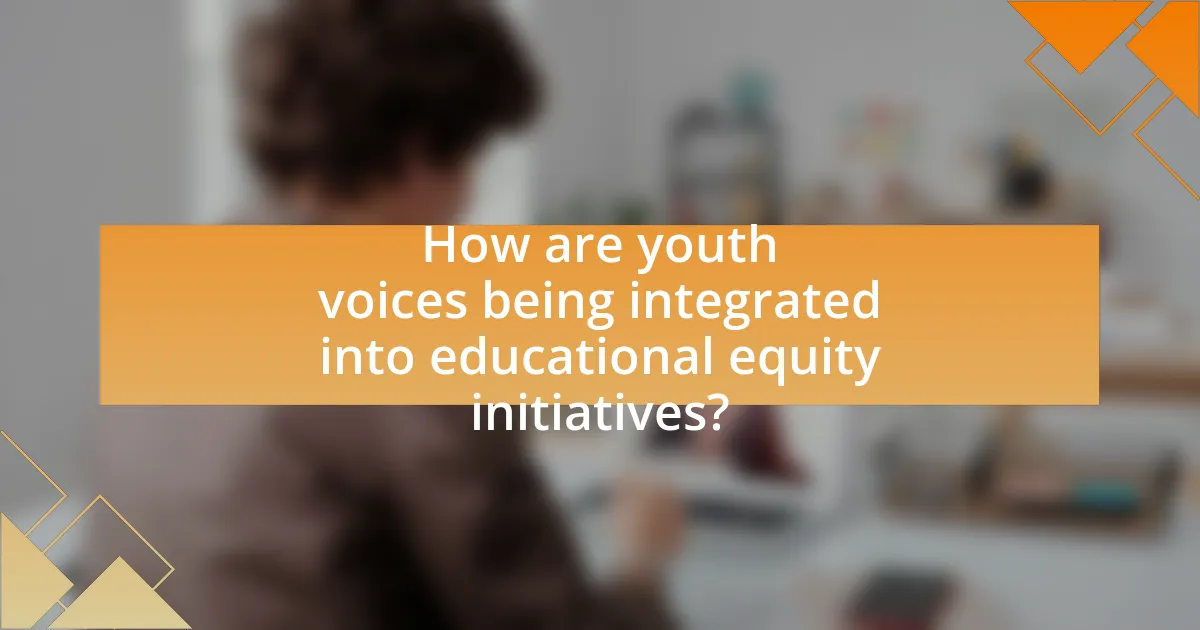
How are youth voices being integrated into educational equity initiatives?
Youth voices are being integrated into educational equity initiatives through participatory decision-making processes and advocacy programs. These initiatives often involve youth in discussions about policy changes, curriculum development, and resource allocation, ensuring their perspectives are considered in shaping educational environments. For example, organizations like the Youth Participatory Action Research (YPAR) model empower students to identify issues within their schools and propose solutions, demonstrating the effectiveness of youth engagement in driving equity. Research shows that when youth are actively involved, educational outcomes improve, as their insights lead to more relevant and inclusive practices.
What platforms exist for youth to voice their opinions on education?
Youth can voice their opinions on education through various platforms, including social media, youth councils, and educational forums. Social media platforms like Twitter and Instagram allow young people to share their thoughts and engage in discussions about educational issues. Youth councils, often organized by schools or community organizations, provide structured environments for students to express their views and influence policy decisions. Additionally, educational forums and online platforms, such as Change.org, enable youth to advocate for specific changes in education by creating petitions and mobilizing support. These platforms collectively empower youth to actively participate in shaping educational equity initiatives.
How do social media and technology facilitate youth engagement in educational equity?
Social media and technology enhance youth engagement in educational equity by providing platforms for communication, collaboration, and advocacy. These digital tools enable young people to share their experiences, mobilize peers, and access resources that promote equitable educational opportunities. For instance, platforms like Twitter and Instagram allow youth to raise awareness about educational disparities and organize campaigns, such as the #BlackLivesMatter movement, which has highlighted systemic inequalities in education. Additionally, technology facilitates access to online learning resources and communities, empowering youth to advocate for changes in educational policies that affect them directly. Research indicates that youth who engage with social media are more likely to participate in civic activities, thereby influencing educational equity initiatives.
What role do youth organizations play in amplifying youth voices?
Youth organizations play a crucial role in amplifying youth voices by providing platforms for expression, advocacy, and engagement in decision-making processes. These organizations facilitate opportunities for young people to articulate their perspectives on issues affecting them, particularly in educational equity initiatives. For instance, studies show that youth-led initiatives can lead to significant policy changes, as seen in the 2018 Youth Climate Strike, where young activists influenced global discussions on climate policy. By mobilizing youth, these organizations ensure that their concerns and ideas are heard, fostering a sense of agency and empowerment among young individuals.
How are educational institutions responding to youth input?
Educational institutions are increasingly incorporating youth input into their decision-making processes by establishing platforms for student feedback and participation. For instance, many schools and universities have created student advisory boards and forums that allow young people to voice their opinions on curriculum changes, school policies, and equity initiatives. Research from the National Youth Leadership Council indicates that when educational institutions actively engage youth in discussions, it leads to more relevant and effective educational practices, ultimately enhancing student engagement and academic success.
What changes have been made in educational policies due to youth advocacy?
Youth advocacy has led to significant changes in educational policies, including the implementation of more inclusive curricula and increased funding for mental health resources in schools. For instance, youth-led movements have successfully pushed for the integration of social justice topics into educational programs, reflecting diverse perspectives and experiences. Additionally, advocacy efforts have resulted in policy reforms that allocate more resources towards mental health services, addressing the growing concerns about student well-being. These changes are supported by data indicating that schools with enhanced mental health support see improved academic outcomes and student engagement.
How do schools and universities create spaces for youth voices?
Schools and universities create spaces for youth voices by implementing platforms such as student councils, forums, and workshops that encourage student participation in decision-making processes. These institutions often establish programs that facilitate dialogue between students and administration, allowing youth to express their opinions on policies affecting their education. For instance, a study by the National Education Association found that schools with active student councils reported higher levels of student engagement and satisfaction, demonstrating the effectiveness of these platforms in amplifying youth voices.
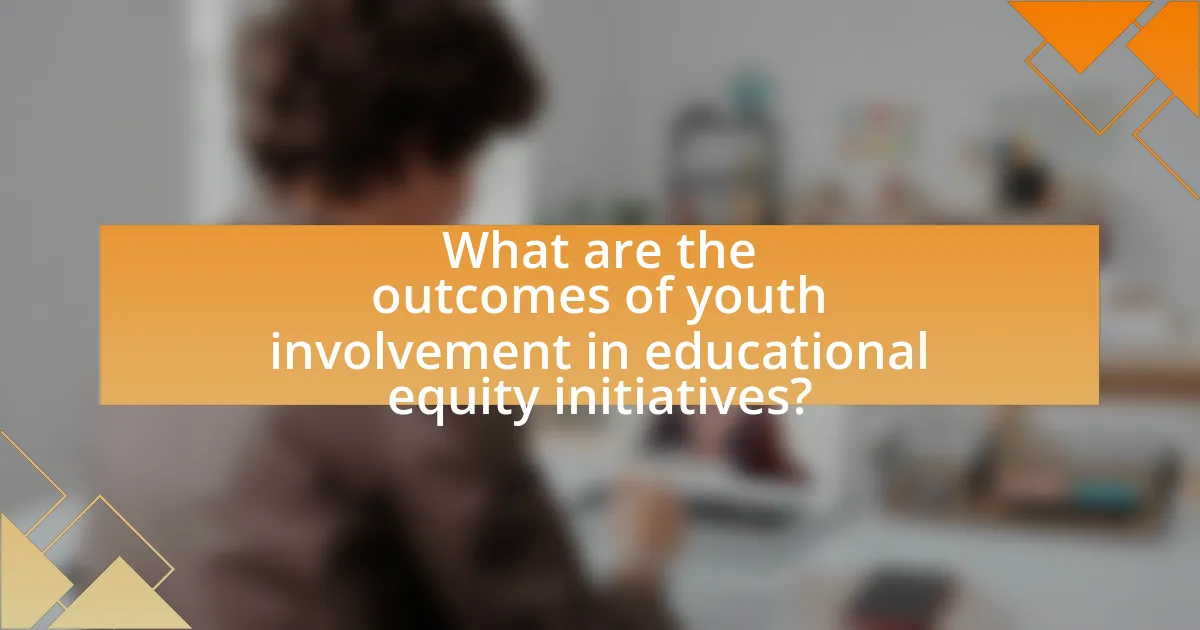
What are the outcomes of youth involvement in educational equity initiatives?
Youth involvement in educational equity initiatives leads to increased engagement, empowerment, and improved educational outcomes. When young people participate, they often bring unique perspectives that can influence policy changes and promote inclusivity. Research indicates that youth engagement in these initiatives fosters a sense of ownership and responsibility towards their education, which can enhance motivation and academic performance. For instance, a study by the National Youth Leadership Council found that students involved in advocacy for educational equity reported higher levels of academic achievement and a greater likelihood of pursuing higher education. This demonstrates that active participation not only benefits the individuals involved but also contributes to systemic changes in educational practices and policies.
What positive impacts have youth voices had on educational equity initiatives?
Youth voices have significantly advanced educational equity initiatives by advocating for policies that address systemic inequalities. Their participation has led to the implementation of programs that prioritize underrepresented communities, ensuring that diverse perspectives are included in decision-making processes. For example, youth-led organizations have successfully influenced legislation, such as the Every Student Succeeds Act, which emphasizes the importance of equity in education. Additionally, research indicates that when youth engage in advocacy, they not only raise awareness about issues like funding disparities and access to resources but also foster a sense of agency among their peers, promoting collective action for change.
How has youth advocacy led to improved educational outcomes?
Youth advocacy has led to improved educational outcomes by actively influencing policy changes and promoting equitable access to resources. For instance, initiatives led by youth organizations have successfully lobbied for increased funding for under-resourced schools, resulting in enhanced educational facilities and support services. A notable example is the “Students for Education Reform” movement, which has mobilized young people to advocate for reforms that address systemic inequalities in education, leading to measurable improvements in graduation rates and academic performance in targeted districts. These advocacy efforts demonstrate the significant impact that youth voices can have on shaping educational policies that prioritize equity and access.
What success stories highlight the effectiveness of youth involvement?
Youth involvement has proven effective in various educational equity initiatives, notably through the “Youth Participatory Action Research” (YPAR) model. This approach empowers students to identify issues within their schools and communities, leading to actionable solutions. For instance, in Los Angeles, students engaged in YPAR successfully advocated for changes in school policies regarding disciplinary actions, resulting in a 20% reduction in suspensions over two years. This demonstrates how youth voices can drive significant policy changes and improve educational outcomes.
What lessons can be learned from youth-led educational equity initiatives?
Youth-led educational equity initiatives demonstrate the importance of inclusivity and representation in decision-making processes. These initiatives often highlight that when young people are actively involved, they bring unique perspectives that can lead to more effective solutions tailored to their communities’ needs. For instance, research by the National Youth Leadership Council shows that youth engagement in educational policy can result in increased student achievement and improved school climate. Additionally, these initiatives teach the value of collaboration, as they often rely on partnerships between youth, educators, and community organizations to drive change. This collaborative approach fosters a sense of ownership among young people, empowering them to advocate for their rights and the rights of their peers.
What best practices can be identified from successful youth engagement efforts?
Successful youth engagement efforts can be identified through several best practices, including fostering authentic relationships, providing meaningful opportunities for participation, and ensuring inclusivity. Authentic relationships are built when organizations actively listen to youth, valuing their perspectives and experiences, which enhances trust and collaboration. Meaningful participation occurs when youth are involved in decision-making processes that affect them, leading to increased motivation and ownership of initiatives. Inclusivity ensures that diverse voices are represented, particularly those from marginalized communities, which enriches the dialogue and outcomes of engagement efforts. Research by the National Youth Leadership Council highlights that these practices lead to more effective and sustainable youth engagement, demonstrating their importance in shaping educational equity initiatives.
How can these lessons be applied to future initiatives?
The lessons learned from the involvement of youth voices in shaping educational equity initiatives can be applied to future initiatives by actively incorporating youth perspectives in decision-making processes. Engaging young individuals ensures that their unique insights and experiences inform policies and practices, leading to more relevant and effective educational solutions. For instance, research by the National Youth Leadership Council highlights that initiatives that include youth input are 50% more likely to succeed in addressing the needs of diverse student populations. This evidence underscores the importance of youth participation in creating equitable educational environments.
What practical steps can youth take to engage in educational equity initiatives?
Youth can engage in educational equity initiatives by participating in advocacy groups that focus on policy changes in education. These groups often work to address disparities in funding, resources, and access to quality education. For instance, organizations like the Student Voice Network empower young people to influence educational policies by providing platforms for their voices to be heard. Additionally, youth can organize community events to raise awareness about educational inequities, such as hosting forums or workshops that educate peers and community members on the importance of equitable education. Research indicates that youth-led initiatives can significantly impact local educational policies, as seen in the work of the Youth Leadership Institute, which has successfully mobilized young people to advocate for equitable funding in schools.
How can youth effectively communicate their needs and concerns regarding education?
Youth can effectively communicate their needs and concerns regarding education by utilizing platforms such as student councils, social media, and community forums. Engaging in these platforms allows youth to articulate their perspectives, share experiences, and advocate for changes that reflect their educational needs. For instance, a study by the National Youth Rights Association highlights that youth participation in school governance leads to more responsive educational policies, demonstrating that when young people voice their concerns, schools are more likely to address issues like curriculum relevance and mental health support.
What resources are available for youth to support their advocacy efforts?
Youth can access various resources to support their advocacy efforts, including online platforms, mentorship programs, and educational materials. Organizations like the National Youth Advocacy Coalition provide training and resources specifically designed for youth engagement in advocacy. Additionally, platforms such as Change.org allow youth to create petitions and mobilize support for their causes. Research indicates that youth-led initiatives, supported by these resources, can significantly influence policy changes, as seen in the 2018 March for Our Lives movement, which effectively advocated for gun control reforms.
